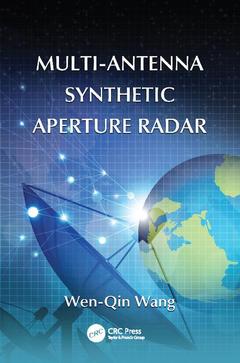Description
Multi-Antenna Synthetic Aperture Radar
Author: Wang Wen-Qin
Language: English
Subjects for Multi-Antenna Synthetic Aperture Radar:
Keywords
MIMO Radar; Spotlight SAR; synthetic aperture radar; Bistatic SAR; SAR; Monostatic SAR; multi-antenna SAR; SAR Configuration; multistatic SAR; Azimuth Resolution; netted SAR; Image Formation Algorithm; multisite SAR; High Azimuth Resolution; distributed SAR; Azimuth Ambiguities; MIMO SAR; LFM Signal; multiple-input multiple-output SAR; Chirp Scaling Algorithm; waveform diversity and design; Conventional SAR; radar signal processing; CS; microwave remote sensing; Range Ambiguities; SAR imaging; Steering Vector; Slant Range; Phase Noise; OFDM Signal; Chirp Waveforms; Range Alignment; OFDM Symbol Time; SAR System; High Resolution SAR Image; Moving Targets
Approximative price 129.58 €
In Print (Delivery period: 14 days).
Add to cartPublication date: 04-2017
· 15.6x23.4 cm · Paperback
Approximative price 244.87 €
In Print (Delivery period: 15 days).
Add to cartPublication date: 05-2013
438 p. · 15.6x23.4 cm · Hardback
Description
/li>Contents
/li>Readership
/li>Biography
/li>
Synthetic aperture radar (SAR) is a well-known remote sensing technique, but conventional single-antenna SAR is inherently limited by the minimum antenna area constraint. Although there are still technical issues to overcome, multi-antenna SAR offers many benefits, from improved system gain to increased degrees-of-freedom and system flexibility. Multi-Antenna Synthetic Aperture Radar explores the potential and challenges of using multi-antenna SAR in microwave remote sensing applications. These applications include high-resolution imaging, wide-swath remote sensing, ground moving target indication, and 3-D imaging. The book pays particular attention to the signal processing aspects of various multi-antenna SAR from a top-level system perspective.
Explore Recent Extensions of Synthetic Aperture Radar Systems
The backbone of the book is a series of innovative microwave remote sensing approaches developed by the author. Centered around multi-antenna SAR imaging, these approaches address specific challenges and potential problems in future microwave remote sensing. Chapters examine single-input multiple-output (SIMO) multi-antenna SAR, including azimuth and elevation multi-antenna SAR, and multiple-input multiple-output (MIMO) SAR. The book details the corresponding system scheme, signal models, time/phase/spatial synchronization methods, and high-precision imaging algorithms. It also investigates their potential applications.
Introductory Tutorials and Novel Approaches in Multi-Antenna SAR Imaging
Rigorous and self-contained, this is a unique reference for researchers and industry professionals working with microwave remote sensing, SAR imaging, and radar signal processing. In addition to novel approaches, the book also presents tutorials that serve as an introduction to multi-antenna SAR imaging for those who are new to the field.
Introduction. Background Material. Azimuth Multi-Antenna SAR. Elevation-Plane Multi-Antenna SAR. MIMO SAR Waveform Diversity and Design. MIMO SAR in High-Resolution Wide-Swath Imaging. MIMO SAR in Moving Target Indication. Distributed Multi-Antenna SAR Time and Phase Synchronization. Distributed Multi-Antenna SAR Antenna Synchronization. Azimuth-Variant Multi-Antenna SAR Image Formation Processing. Multi-Antenna SAR Three-Dimensional Imaging. Bibliography. Index.
Wen-Qin Wang, Ph.D., is currently an associate professor in the School of Communication and Information Engineering at the University of Electronic Science and Technology of China (UESTC), Chengdu. He is also a visiting scholar at the City University of Hong Kong. From June 2011 to May 2012, Dr. Wang was a visiting scholar at the Stevens Institute of Technology, Hoboken, New Jersey. His research interests include communication and radar signal processing and novel radar imaging techniques. He has authored more than 100 papers. Dr. Wang is the recipient of several awards, including the Hong Kong Scholar (2012), the New Century Excellent Talents in University (2012), The Outstanding Young Scholars of Sichuan Province (2012), The Young Scholar of Distinction of UESTC (2012), the Excellent Ph.D. Dissertation of Sichuan Province (2011), the Project Investigator Innovation Award from the Wiser Foundation of the Institute of Digital China (2009), and the Excellent Paper Award of the 12th Chinese Annual Radar Technology Conference (2012). He is an editorial board member of two international journals and was the Technical Program Committee Co-chair of the International Conference on Computational Problem Solving, Chengdu, in 2011.

